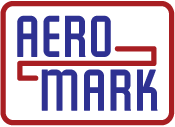 |
AEROMARK 3725 Valley Quail Lane Klamath Falls, OR 97603 Tel (541) 205-5606 Tel (800) 447-9668 aerostamps@aol.com Hours: 9 to 4:00, Monday through Friday |
 |
ink, ink for self-inking rubber stamps, plastic, glass, metal, ink for special materials, supermarking ink, willmark ink by willard marking devices, www.aerostamp.com
 |
AEROMARK 3725 Valley Quail Lane Klamath Falls, OR 97603 Tel (541) 205-5606 Tel (800) 447-9668 aerostamps@aol.com Hours: 9 to 4:00, Monday through Friday |
 |
| INKS - Recomendations for Specific Materials & Application Notes |
| A-A-208D - (Also TT-I-1795A) We have 3 inks that meet this specification: #42M, #141 and #1250 |
| Aircraft Parts - A lot of people use #1250, which meets A-A-208D. However, some types of clear coat will dissolve the impression, so if the spec is open, we recommend #6459, a one part epoxy with excellent adhesion to metals and solvent resistance to such things as kerosene and hydraulic fluid. If you have to meet A-A-56032D, then you’ll have to use #6050 two part epoxy ink. |
Aluminum
- #1250 is the most popular ink. It also meets A-A-208D. #141 also works
well if you need a slower drying time. #6606 is the best, but dries
quickly on the pad. |
| Brass - #628 works well. |
| Cardboard - Ordinary
stamp pad ink usually works, but if you get feathering, switch to #532
indelible ink. |
| Cellophane - #445 Super Marking ink works well as do the #620/#628 plastic marking inks. |
| Ceramics - for glazed ceramics, we recommend #6459, for unglazed, the #532 indelible. |
| Circuit Boards - #432 is generally considered the ink to use on circuit boards as it can take a wide variety of organic solvent baths, and is non-conductive. This ink is aggressive and it requires a metal or special pad, so if your impression is not going through a solvent bath, then the less aggressive #476 may be suitable. (This ink is only available in black.) If you put your boards through a muriatic acid/alkali wash, #6459 is recommended. |
| Cloth - #532 indelible is best. For nylon cloth, use #628 |
| Concrete - #42M is recommended. It a dense ink with excellent is fade resistant and is weatherproof. |
| Fade Resistance - #42M is good for metal, lumber and concrete. If you need faster drying or you have to stamp on a-hard-to-mark surface, use #6606. #667 Opaque (fast) and #532 indelible (slower) inks also have good fade resistance. |
Food Packaging - the following 4 inks all meet USDA guidelines for food packaging: #1250, #141, #620, #628. |
| Glass - With glass, you want a fast drying ink to avoid smudging. #445 Super marking, #6606 and #628 are recommended. |
| High Temperature Inks/Heat resistance - #6459 is good up to 650°F, but if it does not meet your needs, we can special order a specialized high-temperature ink. |
Labels - For stamping non porous labels, #1250 is recommended. It works well on mylar and glossy papers. It is the best ink for foil. Pre-ink stamps with Ultifast multi surface ink can also be used. For non-coated card stock stamps using ordinary stamp pad ink should work. |
| Leather - Use #532 indelible ink. |
| Metal Parts - The best ink for marking metal in terms of adhesion is #6459, but #6606 and #1250 also work well. |
| Mylar - #1250, #141 and #6606 all work well on mylar. |
| Nickel Plating - #6606 is recommended |
| Nylon - #628 is best. |
| Outdoor/Weathering - #42M is your first choice, but #141 is a good alternative. |
| Painted Surfaces - #620 ink will give a dense, waterproof fade resistant impression on painted parts. #42M and #667 opaque ink are also good. #1250 also works well. |
| Paper
- Generally ordinary stamp pad ink is fine. If you you get
feathering due to the porosity of the paper, then #532 Indelible or
#445 Super Marking ink are a good alternatives. For high-gloss surfaces,
use #445 Super Marking ink. |
| Photos - #1250 works best. #445 Super-marking ink is OK. |
| Plastics
- A variety of inks will work on plastic, but some plastics
such as polyethylene are hard to mark. |
| Rubber - #1141 ink is the best for rubber parts. It doesn’t flake off when the surface is flexed, and it dries slowly enough to be usable in metal-frame SELF-INKERS. |
| Shrink Wrap - #620 works well. If you need temperature resistance, contact us. There are specialized inks we can get. |
| Silicone - Nothing really sticks to Silicone. #628 is best. |
| Stainless Steel - #6606 works well on stainless. So does #6459. #1250 will do at a pinch. |
| Tyvek - #620 is best. Dries quickly on the material, but stays moist on the pad for a long time. #6606 also works well. |
| Vinyl/PVC - #1141 rubber marking ink works best on this. |
| Waterproofness - most inks, with the exception of stamp pad ink, are water resistant. #667 Opaque, #532 Indelible and #445 Super Marking are particularly good. The ones to avoid are the plastic marking inks #620 and #628. |
| Wood - Stamping raw wood: indoor, use #532 Indelible, outdoor use #42M. For painted or varnished wood, use #1250 ink or #445 Super Marking ink. |
| Zeytel - is a hard-to-mark plastic. #628 works best. |
|
This page last modified on
February 21, 2024
|